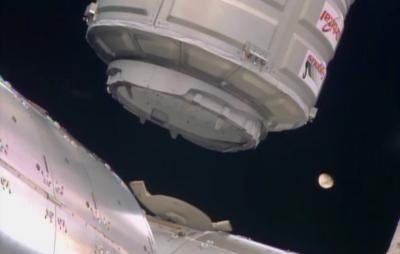Thu, Dec 10, 2015
Fifty-Day Stay Planned At Station
The “S.S. Deke Slayton II” Cygnus spacecraft successfully completed its rendezvous and berthing procedures with the International Space Station (ISS) Wednesday morning. This is the company’s fourth successful berthing with the orbiting laboratory, and the third under NASA’s Commercial Resupply Services (CRS) contract.

Cygnus was launched aboard a United Launch Alliance (ULA) Atlas V rocket on December 6, from Cape Canaveral Air Force Station, Florida. Over the past several days, it completed a series of thruster firings and other maneuvers bringing the spacecraft in close proximity to the ISS. Final approach to the Station began at about 5:00 a.m. (EST), culminating with Expedition 45 crew members grappling Cygnus with the Station’s robotic arm at 6:19 a.m. when it was approximately 30 feet from the ISS. Cygnus was then guided to its berthing port on the nadir side of the Unity module of the ISS where its installation was completed at 9:26 a.m. (EST).
“This mission featured the debut of our enhanced Cygnus, which allowed us to transport approximately 7,700 pounds of essential supplies, equipment and scientific experiments to the astronauts on board the ISS,” said Frank Culbertson, President of Orbital ATK’s Space Systems Group. “That represents a more than 50 percent increase in capacity over the previous Cygnus model. This expanded cargo capability, along with Cygnus’ new UltraFlex solar array and fuel tank enhancements, allows us to deliver greater value to our NASA customer.”
The Expedition 45 crew plans to open the Cygnus hatch and make initial ingress into its cargo module tomorrow to unload the cargo, including food, clothing, crew supplies, spare parts, laboratory equipment and scientific experiments. Cygnus will remain berthed at the ISS for approximately 50 days before departing with approximately 5,050 pounds of disposable cargo for a safe, destructive reentry over the Pacific Ocean.
Under the CRS contract with NASA, Orbital ATK will deliver approximately 62,000 pounds of cargo to the ISS over 10 missions through 2018. To date, the company has delivered more than seven tons of essential supplies to the ISS since the first mission conducted in early 2014, with three additional CRS missions scheduled for 2016. Another Cygnus mission will be launched on an Atlas V in March, after which Orbital ATK’s Antares rocket will launch at least two ISS resupply missions in the second and fourth quarters of 2016.
(Source: Orbital ATK news release.File image from previous mission)
More News
Aero Linx: Model Aeronautical Association of Australia MAAA clubs are about fun flying, camaraderie and community. For over 75 years, the MAAA has been Australia’s largest fl>[...]
Touchdown Zone Lighting Two rows of transverse light bars located symmetrically about the runway centerline normally at 100 foot intervals. The basic system extends 3,000 feet alon>[...]
“Discovery and innovation are central to our mission at Virgin Galactic. We’re excited to build on our successful record of facilitating scientific experiments in subor>[...]
How To Get A Story On Aero-TV News/Feature Programming How do I submit a story idea or lead to Aero-TV? If you would like to submit a story idea or lead, please contact Jim Campbel>[...]
Student Pilot Reported That During Rotation, “All Of A Sudden The Back Of The Plane Kicked To The Right..." Analysis: The student pilot reported that during rotation, “>[...]
 ANN's Daily Aero-Linx (05.02.24)
ANN's Daily Aero-Linx (05.02.24) ANN's Daily Aero-Term (05.02.24): Touchdown Zone Lighting
ANN's Daily Aero-Term (05.02.24): Touchdown Zone Lighting Aero-News: Quote of the Day (05.02.24)
Aero-News: Quote of the Day (05.02.24) ANN FAQ: Contributing To Aero-TV
ANN FAQ: Contributing To Aero-TV NTSB Final Report: Cirrus Design Corp SR20
NTSB Final Report: Cirrus Design Corp SR20



